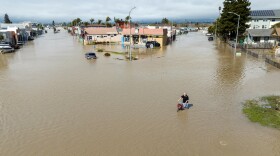Under clear blue skies, the flood feels like a distant memory. Main street is back to its former hustle and bustle, with traffic and open businesses. But not everything has returned to normal in Pajaro.

“The house is not the same,” said Tomas Garcia. His family has owned their home in Pajaro since 1985. Now, it sits mostly empty of furniture. Its bare walls are in need of paint, and parts of the roof have been replaced with corrugated plastic.
“We wish we could have finished this two or three months ago,” he said. “But everything has to do with funds.”
They recently replaced their floors, but now repairs are stalled as Garcia waits on appeals to FEMA and his insurance company. Meanwhile the family is staying with relatives in Watsonville.

“I don’t feel safe yet until we finish all this,” he said. ”We still need to do a lot of things.”
Like Garcia, much of Pajaro is struggling to return to normal. The Pajaro Middle School and public library remain closed. Occasionally, an abandoned vehicle covered in grime sits on the roadside. Residents say they were left behind after the flood, and now serve as lingering reminders of the lives that are still upended.
For Michele Keith, the disaster that started on March 10 has felt relentless.
“Nobody understands what we’re going through,” she said. Keith was living in her parents' home when they were evacuated.
“My mom and dad lost everything on the lower half of the house,” she said. “They were there 25 years.”
For months, she stayed alongside dozens of other displaced Pajaro residents at a hotel in Watsonville, provided by Monterey County. But the program ended on Aug. 23.
“How am I supposed to work and be stressed out about a place to stay?” she said. “It’s just been so upsetting.”
A spokesperson for Monterey County said the hotel program helped more than 200 people transition into permanent housing. But 60 residents, including Keith, still lived at the hotel when the program ended. They were offered another hotel option in Marina, but nearly half opted not to make the move.

Monica Chavez-Gonzalez, a case manager at local non-profit Community Bridges, said many people can’t afford a new rental.
"It takes about $10,000 just to get into a place,” she said, when considering first and last month’s rent plus security deposit.
Community Bridges has helped residents navigate FEMA appeals, file insurance claims, and locate housing options. In addition to the high cost of living, the agricultural fields surrounding Pajaro were damaged. Chavez-Gonzalez says many people lost their jobs.
“When you have to deal with the families in that situation, and see the struggles they go through with the kids, the schools, the jobs, a lot of the displacement,” Chavez-Gonzazez said. “It’s just hard.”
A survey by the Monterey County Agricultural Commission found that 5% of the county’s agricultural lands were destroyed by the storms — most of them centered in the Pajaro Valley. In total, floods and rain caused $600 million in damages. Strawberries, a major Pajaro Valley crop, were hit hardest of all.

Federal and state support has bolstered recovery efforts. After President Biden delcared a federal disaster in April, FEMA has provided over $5.5 million in aid. And the state made $95 million available to help support undocumented residents, who cannot access other forms of support, like unemployment insurance or federal assistance.
Gov. Newsom also signed a budget plan in June that carved out $20 million specifically to support Pajaro’s recovery.
Vicente Lara, who works for Monterey County, says a task force is working with the community to decide how to best spend that money.
“Recognizing that we’re not all at the same place,” he said. “We really have to support, especially, those residents who are still struggling in any way we can.”
The task force expects to make recommendations to county supervisors within six to 12 months.
Meanwhile, crews are expected to complete work on the levee before winter, but current repairs will only bring the levee back to its condition before the devastating floods in March. Major upgrades are still years away.
That leaves residents like Tomas Garcia worried about the approaching winter, and racing to complete his own repairs.
“We’re really concerned about that,” Garcia said. “That’s why we try to finish this, to make the house a little bit more secure.”
The family has been through all this before, when the Pajaro levee breached in 1995. Back then, Garcia's father repaired the home himself, without help from the government.
Nearly 30 years later, Garcia's father sits in his empty living room, breathing with the help of an oxygen tank. Garcia believes the stress of the floods has worsened his health.

“The situation, the stress, the pressure, a lot of things combined puts pressure to his heart,” Garcia said. “He’s trying to survive and move forward, to be with us a little bit more time.”
The family discussed leaving Pajaro to search for a fresh start in a place with less risk.
“My father doesn’t want to leave,” Garica said. “He wants to spend his time right here.”
And that leaves only one option: rebuild, and like the rest of Pajaro, hope the levee holds this winter.







